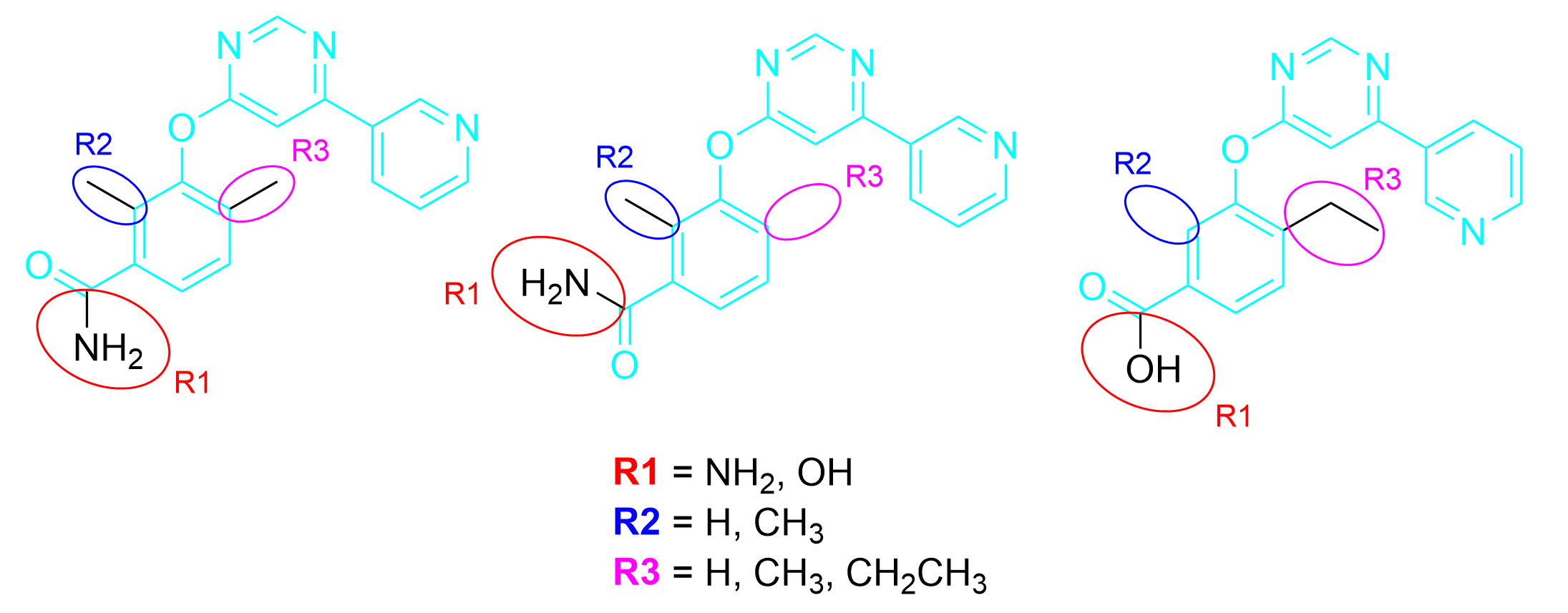5.3 – Solutions for Chapter 4 – Chemical Biology
Chapter 4.4 – Combinatorial Chemistry
1. How many sites of diversity are there in this combinatorial library?

A. 6
B. 4
C. 8
D. 3
The correct answer to this question is Option B. The first step in determining the sites of diversity is to determine the core structure of the compounds. The core structure stays consistent and appears in every compound shown. If a substituent only appears in some of the molecules, then it is not considered part of the core structure. The figure below highlights it in cyan.

Now that the core structure has been determined, we can look at the points at each part of the molecule where there is a different substituent. For example, the bottom left can either be NH2, OH or CH3, making this one site of diversity. The same can be said for the site on the left of the central ring, where there is either a carbon group (CH3) or no visible groups, meaning it only has the substituent H. This is the second site of diversity.
On the right of the central ring, once again, it is shown to either be CH3 (a carbon group) or H. This is the third site of diversity.
The last site of diversity may be tricky because it occurs right in the middle of the molecule, rather than branching out somewhere. However, since it is different in each compound (containing either an oxygen, carbon, or nitrogen group), it can be considered a fourth site of diversity.

This makes the answer to this question Option B, with 4 sites of diversity seen in this library of compounds.
2. How many compounds would a combinatorial library contain based on the compounds below? (Every substituent can be found at every diversity site.)

A. 125
B. 216
C. 512
D. 1296
The correct answer to this question is Option A. The first step in determining the sites of diversity is to determine the core structure of the compounds. The core structure stays consistent and appears in every compound shown. If a substituent only appears in some of the molecules, then it is not considered part of the core structure. The figure below highlights it in cyan.

One difficult core structure to locate is the top-right ring, which is highlighted below in dark blue. Although the third molecule seemingly looks different than the first two, prompting you to think it is a diversity site, these sites are actually exactly the same – the rings are simply flipped. An easy way to decipher this is to count what position the nitrogen is relative to the carbon bonded to the rest of the structure. If we label carbon bonded to the rest of the structure as position 1, it can be seen that in all three molecules, the nitrogen is three positions away. As the rest of the ring looks the same with the double bonds in the same locations, this is NOT a site of diversity and is actually part of the core structure of the compounds.

Now that the core structure has been determined, we can look at the points at each part of the molecule where there is a different substituent. For example, the bottom left of the molecule next to the carbonyl group is shown to either contain a nitrogen group (NH3) or hydroxide group (OH). Thus, this can be considered a site of diversity.
The same can be done for the sites on the left and right of the bottom central ring. On the left side, there can either be one carbon group (CH3) or no groups (H). On the right side, there is seen to either be no groups (H), one carbon group (CH3) or two carbons (CH2CH3). Thus, these are the second and third sites of diversity.

Now that we know the sites of diversity, we can identify the different substituents at each site. This is best done in a list format to sort what substituents are found at each site. As the question states that every substituent can be found at every site, we can then extend the list of possible substituents to include ones that are found at other sites of diversity as well. An example of a list is found below. The left side lists what substituents are found on the three molecules at each site. We then extend the list by ensuring every substituent is listed at each site. A total of five unique substituents are found at each diversity site.

Lastly, we can apply our formula, which is the number of substituents to the power of the number of diversity sites. This gives the final answer to be Option A, or 125 different compounds.


